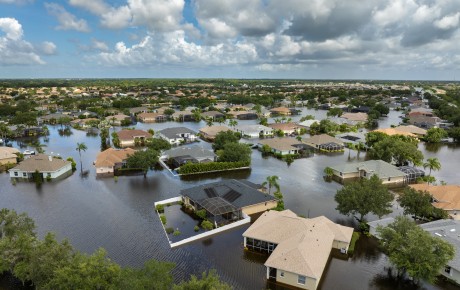
The changing profile of US flood risk
2024 was another record breaking year for US flood risk with 31.58 inches of rainfall making it the third wettest year since 1895. September’s Hurricane Helene dropped up to 30 inches of rain alone, causing catastrophic flooding in North Carolina with FEMA’s National Flood Insurance Program (NFIP) receiving more than 57,000 claims totalling more than $4.5 billion (as of 6 February 2025). But, in addition to the volume of water, also noticeable was a continuation of recent trends that point to an extension of the flood season into previously drier months and flooding in what historically were largely unaffected inland areas. “This rapidly changing flood risk profile means it’s critical we take the lessons learned from recent years and how they can be applied not just to our own view of flood risk as an insurer, but also what those learnings mean for our coverholders, brokers, agents, and ultimately, the customers themselves and the implications for their own flood precautions,” says Hiscox’s Tom King – Flood Line Underwriter.
Flood events year round
Traditionally the hurricane season runs from the beginning of June to the end of November, but analysis of recent Hiscox claims data would appear to show how the distribution of flood claims is becoming wider than just those six months. “There is an identifiable trend of flood claims occurring in more months every year with a potential trend of not only a longer hurricane season but increased flooding from other natural events, such as atmospheric rivers, happening earlier and later in the year,” says King. “During 2024 we saw flood related claims in every month with June, September and October busy as expected, but January was also busy. 2023 showed claims distributed across the year, with activity outside of the traditional flood period in January, March, and December. While 2022 also saw claims in December. It’s a change of exposure that indicates customers will need to get ready for flood risk at all times of the year.”
Inland properties at risk
Tied in with this seasonal variation in flooding, claims are increasingly being seen related to inland properties. FEMA estimates that total flood insurance claims losses for Hurricane Helene will fall between US$6.4 billion to US $7.4 billion with inland areas such as the southern Appalachian Mountains hit just as hard, if not harder, than coastal regions. “Over half of our flood claims have been within a mile from the coast, but we’re now seeing two in ten occurring more than 10 miles from the coast,” says King. “This trend has increased in recent years, with X zones – those areas defined by FEMA as having a low-to-moderate flood risk – accounting for one in ten of our losses as climate patterns change.”
Just as striking, adds King, is the recent appearance of inland US states in Hiscox’s flood claims data that previously did not feature. “This can be partially explained by the growth of our flood book into new areas, but it’s also the case that we are seeing flood claims in inland states that would very rarely have experienced such events. Property owners, both residential and commercial, in states such as New Mexico, Nevada and Montana – just some of the inland states where we have seen flood claims – will need to think about their flood risk profile and the ways they could improve this through additional flood defence features in their homes. They should also consider flood insurance if they haven’t already and as an industry, it’s our responsibility to keep evolving our coverage to fit their needs, either with bespoke limits and/or a favourable and reflective price point for their risk exposure.”
Adapting to the changing risk profile
What does this changing risk profile mean for the insurance industry? “Firstly, the increased unpredictability around the time of year and location of flood losses mean insurers will need to continue working hard to accurately model potential losses to guarantee a sustainable product in the long term,” says King. That also means adapting to a possible change in the nature of losses. “The surge events that we see on the coast arrive rapidly but also retreat quickly. In contrast, inland riverine flooding following significant rainfall and saturated ground can last longer, potentially inflicting more damage on homes and property due to the length of time that water sits in the house or office building,” adds King. “That’s why it is key that customers review their flood policies to make sure such losses are comprehensively covered.”
Availability and affordability are key
It’s also evident that, as inland regions become increasingly vulnerable to flood risk, more must be done to improve awareness and access to flood insurance. “It's up to us as an industry to expand our focus to new areas where flood insurance has not been seen as a necessary purchase, while working hard to drive up demand by raising awareness amongst customers as to the need for flood protection. It’s important that people understand their individual flood risk and know there are steps they can take to mitigate or reduce the severity of a flood incident,” says King. “That means developing products that are easily accessible, with broad coverage, and are affordable. The private flood insurance market is already doing a good job in growing the product but, as our claims data highlights, the increased unpredictability of when and where we’ll see flooding in the future means we must continue to innovate and educate.”




